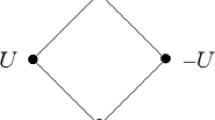Abstract
This paper presents a new theory of vagueness, which is designed to retain the virtues of the fuzzy theory, while avoiding the problem of higher-order vagueness. The theory presented here accommodates the idea that for any statement S 1 to the effect that ‘Bob is bald’ is x true, for x in [0,1], there should be a further statement S 2 which tells us how true S 1 is, and so on – that is, it accommodates higher-order vagueness – without resorting to the claim that the metalanguage in which the semantics of vagueness is presented is itself vague, and without requiring us to abandon the idea that the logic – as opposed to the semantics – of vague discourse is classical. I model the extension of a vague predicate P as a blurry set, this being a function which assigns a degree of membership or degree function to each object o, where a degree function in turn assigns an element of [0,1] to each finite sequence of elements of [0,1]. The idea is that the assignment to the sequence 〈0.3,0.2〉, for example, represents the degree to which it is true to say that it is 0.2 true that o is P to degree 0.3. The philosophical merits of my theory are discussed in detail, and the theory is compared with other extensions and generalisations of fuzzy logic in the literature.
Similar content being viewed by others
References
Barker, J., 1998: The inconsistency theory of truth, Ph.D. thesis, Department of Philosophy, Princeton University.
Cantor, G., 1915: Contributions to the Founding of the Theory of Transfinite Numbers, Dover, New York. Translated by Philip E. B. Jourdain.
Copeland, B. J., 1997: Vague identity and fuzzy logic, J. Philos. 94, 514-534.
Dubois, D. and Prade, H., 1980: Fuzzy Sets and Systems: Theory and Applications, Academic Press, New York.
Fine, K., 1975: Vagueness, truth and logic, in (Keefe and Smith, 1997), pp. 119-150.
Hisdal, E., 1981: The IF THEN ELSE statement and interval-valued fuzzy sets of higher type, Internat. J. Man-Machine Studies 15, 385-455.
Islam, A., 1996: The abstract and the concrete, Typescript.
John, R., 1998: Type 2 fuzzy sets: An appraisal of theory and applications, Internat. J. Uncertainty, Fuzziness and Knowledge-Based Systems 6, 563-576.
Karnik, N. N., Mendel, J. M. and Liang, Q., 1999: Type-2 fuzzy logic systems, IEEE Trans. on Fuzzy Systems 7, 643-658.
Keefe, R., 2000: Theories of Vagueness, Cambridge University Press, Cambridge.
Keefe, R. and Smith, P. (eds.), 1997: Vagueness: A Reader, MIT Press, Cambridge, MA.
Kleene, S. C., 1952: Introduction to Metamathematics, D. Van Nostrand, Princeton.
Klir, G. J. and Yuan, B., 1995: Fuzzy Sets and Fuzzy Logic: Theory and Applications, Prentice-Hall, Upper Saddle River, NJ.
Kripke, S., 1975: Outline of a theory of truth, J. Philos. 72, 690-716.
Liang, Q. and Mendel, J. M., 2000: Interval type-2 fuzzy logic systems: Theory and design, IEEE Trans. on Fuzzy Systems 8, 535-550.
Mizumoto, M. and Tanaka, K., 1976a: Fuzzy-fuzzy automata, Kybernetes 5, 107-112.
Mizumoto, M. and Tanaka, K., 1976b: Some properties of fuzzy sets of type 2, Inform. and Control 31, 312-340.
Mizumoto, M. and Tanaka, K., 1981: Fuzzy sets of type 2 under algebraic product and algebraic sum, Fuzzy Sets and Systems 5, 277-290.
Nguyen, H. T. and Walker, E. A., 2000: A First Course in Fuzzy Logic, 2nd edn, Chapman & Hall/CRC, Boca Raton.
Nieminen, J., 1977: On the algebraic structure of fuzzy sets of type-2, Kybernetika 13.
Rosen, G. and Smith, N. J. J., 2004: Worldly indeterminacy: A rough guide, Australasian J. Philos. 82(1).
Smith, N. J. J., 2001: Vagueness, Ph.D. thesis, Department of Philosophy, Princeton University. UMI ProQuest Digital Dissertations no. AAT 3021982 (http://wwwlib.umi.com/dissertations/fullcit/3021982).
Smith, N. J. J., 2003: Vagueness and degrees of truth, forthcoming.
Visser, A., 1989: Semantics and the Liar paradox, in D. Gabbay and F. Guenthner (eds.), Handbook of Philosophical Logic, Vol. IV, D. Reidel Publishing Company, pp. 617-706.
Williamson, T., 1992: Vagueness and ignorance, in (Keefe and Smith, 1997), pp. 265-280.
Williamson, T., 1994: Vagueness, Routledge, London.
Wright, C., 1987: Further reflections on the Sorites paradox, Philos. Topics 15, 227-290.
Yager, R. R., 1980: Fuzzy subsets of Type II in decisions, J. Cybernet. 10, 137-159.
Yager, R. R., 1984: Fuzzy subsets with uncertain membership grades, IEEE Trans. Systems Man Cybernet. 14, 271-275.
Zadeh, L. A., 1975a: The concept of a linguistic variable and its application to approximate reasoning — I, II, III, Inform. Sci. 8–9, 199-249, 301–357, 43–80.
Zadeh, L. A., 1975b: Fuzzy logic and approximate reasoning, Synthese 30, 407-428.
Author information
Authors and Affiliations
Rights and permissions
About this article
Cite this article
Smith, N.J.J. Vagueness and Blurry Sets. Journal of Philosophical Logic 33, 165–235 (2004). https://doi.org/10.1023/B:LOGI.0000021717.26376.3f
Issue Date:
DOI: https://doi.org/10.1023/B:LOGI.0000021717.26376.3f




